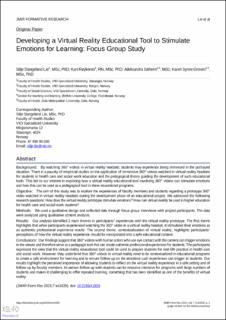| dc.contributor.author | Lie, Silje Stangeland | |
| dc.contributor.author | Røykenes, Kari | |
| dc.contributor.author | Sæheim, Aleksandra | |
| dc.contributor.author | Groven, Karen Synne | |
| dc.date.accessioned | 2024-04-09T11:56:16Z | |
| dc.date.available | 2024-04-09T11:56:16Z | |
| dc.date.created | 2023-03-21T09:57:30Z | |
| dc.date.issued | 2023 | |
| dc.identifier.citation | JMIR Formative Research. 2023, 7, Artikkel e41829. | en_US |
| dc.identifier.issn | 2561-326X | |
| dc.identifier.uri | https://hdl.handle.net/11250/3125523 | |
| dc.description.abstract | Background: By watching 360° videos in virtual reality headsets, students may experience being immersed in the portrayed situation. There is a paucity of empirical studies on the application of immersive 360° videos watched in virtual reality headsets for students in health care and social work education and the pedagogical theory guiding the development of such educational tools. This led to our interest in exploring how a virtual reality educational tool involving 360° videos can stimulate emotions and how this can be used as a pedagogical tool in these educational programs.
Objective: The aim of this study was to explore the experiences of faculty members and students regarding a prototype 360° video watched in virtual reality headsets during the development phase of an educational project. We addressed the following research questions: How does the virtual reality prototype stimulate emotions? How can virtual reality be used in higher education for health care and social work students?
Methods: We used a qualitative design and collected data through focus group interviews with project participants. The data were analyzed using qualitative content analysis.
Results: Our analysis identified 2 main themes in participants’ experiences with the virtual reality prototype. The first theme highlights that when participants experienced watching the 360° video in a virtual reality headset, it stimulated their emotions as an authentic professional experience would. The second theme, contextualization of virtual reality, highlights participants’ perceptions of how the virtual reality experience should be incorporated into a safe educational context.
Conclusions: Our findings suggest that 360° videos with human actors who use eye contact with the camera can trigger emotions in the viewer and therefore serve as a pedagogic tool that can create authentic professional experiences for students. The participants expressed the view that the virtual reality educational tool could be used to prepare students for real-life practice in health care and social work. However, they underlined that 360° videos in virtual reality need to be contextualized in educational programs to create a safe environment for learning and to ensure follow-up on the emotions such experiences can trigger in students. Our results highlight the perceived importance of allowing students to reflect on the virtual reality experience in a safe setting and of follow-up by faculty members. In-person follow-up with students can be resource intensive for programs with large numbers of students and makes it challenging to offer repeated training, something that has been identified as one of the benefits of virtual
reality. | en_US |
| dc.language.iso | eng | en_US |
| dc.publisher | JMIR Publications | en_US |
| dc.rights | Navngivelse 4.0 Internasjonal | * |
| dc.rights.uri | http://creativecommons.org/licenses/by/4.0/deed.no | * |
| dc.subject | virtual reality | en_US |
| dc.subject | 360° video | en_US |
| dc.subject | learning | en_US |
| dc.subject | experiences | en_US |
| dc.subject | emotions | en_US |
| dc.subject | health care and social work higher education | en_US |
| dc.title | Developing a Virtual Reality Educational Tool to Stimulate Emotions for Learning: Focus Group Study | en_US |
| dc.type | Peer reviewed | en_US |
| dc.type | Journal article | en_US |
| dc.description.version | publishedVersion | en_US |
| dc.rights.holder | ©Silje Stangeland Lie, Kari Røykenes, Aleksandra Sæheim, Karen Synne Groven. | en_US |
| dc.subject.nsi | VDP::Samfunnsvitenskap: 200::Pedagogiske fag: 280 | en_US |
| dc.source.volume | 7 | en_US |
| dc.source.journal | JMIR Formative Research | en_US |
| dc.identifier.doi | 10.2196/41829 | |
| dc.identifier.cristin | 2135606 | |
| dc.source.articlenumber | e41829 | en_US |
| cristin.ispublished | true | |
| cristin.fulltext | original | |
| cristin.qualitycode | 1 | |

